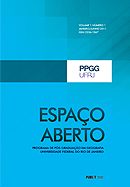Rainfall Interception in Mangrove in the Southeastern Coast of Brazil
DOI:
https://doi.org/10.36403/espacoaberto.2016.3282Keywords:
Rain, Mangrove, MicroclimaAbstract
Mangroves are among the ecosystems biologically more productive and important in the world, providing unique goods and services to societies and coastal systems. These areas, however, are increasingly fragmented, contributing to the loss of their services and benefits. The rains have an important influence in this ecosystem is central to the dissolution of sea salts. This study investigated the total rainfall in the mangroves located in the Coastal System Cananeia-Iguape (SP) at different time scales (daily, monthly, sea-sonal and annual) and its interception by the mangrove canopy. It found an intercept of 8.8%, ranging from 13% to 4% in the annual scale, showing that the annual variation of rainfall, which reflects both its quantity and its intensity contributes to the percentage of that interception by the canopy. It was also found that as the intensity of precipitation increases, trapping the mangrove canopy reduces.


